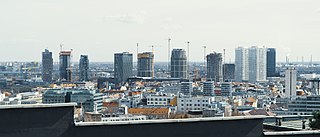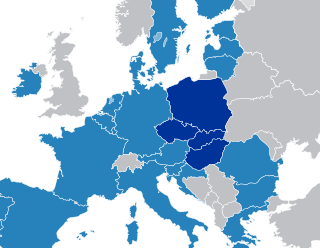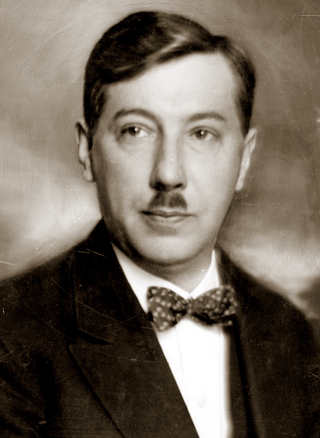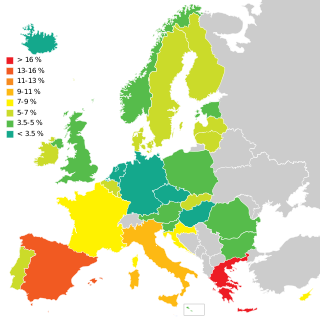Related Research Articles

The Second Polish Republic, at the time officially known as the Republic of Poland, was a country in Central and Eastern Europe that existed between 11 November 1918 and 17 September 1939. The state was established at the end of the First World War. The Second Republic ceased to exist in 1939, when Poland was invaded by Nazi Germany, the Soviet Union and the Slovak Republic, marking the beginning of the European theatre of the Second World War. The Polish government-in-exile was established in Paris to replace the Second Republic in the war.

Lesser Poland, often known by its Polish name Małopolska, is a historical region situated in southern and south-eastern Poland. Its capital and largest city is Kraków. Throughout centuries, Lesser Poland developed a separate culture featuring diverse architecture, folk costumes, dances, cuisine, traditions and a rare Lesser Polish dialect. The region is rich in historical landmarks, monuments, castles, natural scenery and UNESCO World Heritage Sites.

The economy of Poland is an industrialized, mixed economy with a developed market that serves as the sixth-largest in the European Union by nominal GDP and fifth-largest by GDP (PPP). Poland boasts the extensive public services characteristic of most developed economies. Since 1988, Poland has pursued a policy of economic liberalization but retained an advanced public welfare system. This includes universal free public healthcare and education, extensive provisions of free public childcare and parental leave. The country is considered by many to be a successful post-communist state. It is classified as a high-income economy by the World Bank, ranking 22nd worldwide in terms of GDP (PPP), 23rd in terms of GDP (nominal), and 23rd in the 2018 Economic Complexity Index.

The economy of Slovakia is based upon Slovakia becoming an EU member state in 2004, and adopting the euro at the beginning of 2009. Its capital, Bratislava, is the largest financial centre in Slovakia. As of Q1 2018, the unemployment rate was 5.72%.

The Visegrád Group is a cultural and political alliance of four Central European countries: the Czech Republic, Hungary, Poland, and Slovakia. The alliance aims to advance co-operation in military, economic, cultural and energy affairs, and to further their integration with the EU. All four states are also members of the European Union (EU), the North Atlantic Treaty Organization (NATO), and the Bucharest Nine (B9).

The history of interwar Poland comprises the period from the revival of the independent Polish state in 1918, until the Invasion of Poland from the West by Nazi Germany in 1939 at the onset of World War II, followed by the Soviet Union from the East two weeks later. The two decades of Poland's sovereignty between the world wars are known as the Interbellum.

Leszek Henryk Balcerowicz is a Polish economist, statesman, and Professor at Warsaw School of Economics. He served as Chairman of the National Bank of Poland (2001–2007) and twice as Deputy Prime Minister of Poland. In 1989, he became Minister of Finance in Tadeusz Mazowiecki's first non-communist government and led the free-market economic reforms, proponents of which say they have transformed Poland into one of Europe's fastest growing economies, but which critics say were followed by a large increase in unemployment. In 2007, he founded the Civil Development Forum think-tank and became the chairman of its council.

Sandomierz Voivodeship was a unit of administration and local government in Poland from the 14th century to the partitions of Poland in 1772–1795. It was part of the Lesser Poland region. Originally Sandomierz Voivodeship also covered the area around Lublin, but in 1474 its three eastern counties were organized into Lublin Voivodeship. In the 16th century, it had 374 parishes, 100 towns and 2586 villages. The voivodeship was based on the Sandomerz ziemia, which earlier was the Duchy of Sandomierz. The Duchy of Sandomierz was created in 1138 by King Bolesław III Wrymouth, who in his testament divided Poland into five principalities. One of them, with the capital at Sandomierz, was assigned to Krzywousty's son, Henry of Sandomierz. Later on, with southern part of the Seniorate Province, the Duchy of Sandomierz created Lesser Poland, divided into Kraków and Sandomierz Voivodeships.
The Central Industrial District, is an industrial region in Poland. It was one of the biggest economic projects of the Second Polish Republic. The 5-year-long project was initiated by a famous Polish economist, deputy Prime Minister and Minister of the Treasury, Eugeniusz Kwiatkowski. Its goal was to create a heavy industrial center in the middle of the country, as far as possible from any borders, strengthen the Polish economy and reduce unemployment. The four-year plan for the development of COP was scheduled from 1 September 1936 until 30 July 1940 and was interrupted by the outbreak of the Second World War and the German invasion of Poland on 1 September 1939. Nonetheless, the COP project succeeded in vastly expanding Polish industry, and after the end of the war in 1945 COP was rebuilt and expanded under the People's Republic of Poland.

Eugeniusz Kwiatkowski was a Polish politician and economist, Deputy Prime Minister of Poland, government minister and manager of the Second Polish Republic.
The Balcerowicz Plan, also termed "Shock Therapy", was a method for rapidly transitioning from an economy based on state ownership and central planning, to a capitalist market economy. A group of experts, which they formed together with Balcerowicz, including Dr. Stanisław Gomułka, Dr. Stefan Kawalec and Dr. Wojciech Misiąg, in September 1989 created a reform plan based on an earlier idea of prof. Jeffrey Sachs, and on October 6, an outline of this plan was presented to the public by Balcerowicz at a press conference broadcast by TVP.

Mościce is industrial district of Tarnów, Poland. In the 1920s, there was located the National Factory of Nitric Compounds. Currently, the enterprise operates as Grupa Azoty S.A. and its Capital Group focuses the largest plants of great chemical synthesis in the country that are located in Tarnów, Police, Kędzierzyn-Koźle and Puławy, at the same time, it is the leading producer of mineral fertilisers, construction plasticisers as well as OXO alcohols and plasticisers in Poland and Europe.
The Five-Year Plans of Vietnam are a series of economic development initiatives. The Vietnamese economy is shaped primarily by the Vietnamese Communist Party through the plenary sessions of the Central Committee and national congresses. The party plays a leading role in establishing the foundations and principles of communism, mapping strategies for economic development, setting growth targets, and launching reforms.

Polesie Voivodeship was an administrative unit of interwar Poland (1918–1939), named after the historical region of Polesia. It was created by the Council of Ministers of the Second Polish Republic on February 19, 1921, as a result of peace agreement signed with the Russian and Ukrainian SSRs in Riga. Polesie Voivodeship was the largest province of interwar Poland. It ceased to function in September 1939, following the Nazi-German and Soviet invasion of Poland in accordance with a secret protocol of the Nazi–Soviet Pact of non-aggression.
Old Polish Industrial Region is an industrial region in northern part of Lesser Poland. It is the oldest and in terms of area covered, largest of Polish industrial regions. Most of the region is located in Lesser Poland Upland, and its historic center lies along the Kamienna river. Primary industrial cities: Kielce, Radom, Ostrowiec Świętokrzyski, Starachowice and Skarżysko-Kamienna.

Sandomierz Voivodeship was a proposed voivodeship of the Second Polish Republic, which was never created because of the Nazi and Soviet invasion of Poland in September 1939. The idea of the creation of this unit was the brainchild of the Minister of Industry and Trade Eugeniusz Kwiatkowski, and it was directly linked with creation of one of the biggest economic projects of interbellum Poland, Central Industrial Region. It was intended to cover south-central Poland and be created in late 1939. Its projected size was 24,500 square kilometers, and it was to incorporate 20 or 21 powiats.

Sztafeta is a 1939 compendium of literary reportage written by Melchior Wańkowicz. It was published in the year of the German-Soviet invasion of Poland. Popular demand caused it to be reprinted four times by the Biblioteka Polska before the outbreak of hostilities. The book was never published in Communist Poland because it praised the democratic achievements of the prewar Second Polish Republic.

Unemployment in Poland appeared in the 19th century during industrialization, and was particularly severe during the Great Depression. Under communist rule Poland officially had close to full employment, although hidden unemployment existed. After Poland's transition to a market economy the unemployment rate sharply increased, peaking at above 16% in 1993, then dropped afterwards, but remained well above pre-1993 levels. Another period of high unemployment occurred in the early 2000s when the rate reached 20%. As Poland entered the European Union (EU) and its job market in 2004, the high unemployment set off a wave of emigration, and as a result domestic unemployment started a downward trend that continued until the onset of the 2008 Great Recession. Recent years have seen an increase in the unemployment rate from below 8% to above 10% (Eurostat) or from below 10% to 13% (GUS). The rate began dropping again in late 2013. Polish government (GUS) reported 9.6% registered unemployment in November 2015, while European Union's Eurostat gave 7.2%. According to Eurostat data, since 2008, unemployment in Poland has been constantly below the EU average. Significant regional differences in the unemployment rate exist across Poland.

Why didn't you invest in Eastern Poland? was an advertising campaign conducted by the Polish Information and Foreign Investment Agency (PAIiIZ), and supported by the European Regional Development Fund, to raise the domestic and international profile of Eastern Poland, with the aim of increasing economic investment in the region.

The economy of the Socialist Republic of Romania was centrally planned, similar to the one of the Soviet Union. Most of the means of production were owned by the state, which established production plans as part of the Five-Year Plans.
References
- ↑ Wprost weekly, the Sejm honored memory of Eugeniusz Kwiatkowski
- ↑ "History of Sandomierz, the 1930s". Archived from the original on 2007-11-03. Retrieved 2009-03-17.
- ↑ An Economic History of Twentieth-century Europe By Tibor Iván Berend, page 69
- ↑ Poland, 1918-1945 By Peter D. Stachura, page 51
- ↑ http://www.lwow.home.pl/spotkania/pilsudski/8.pdf [ bare URL PDF ]